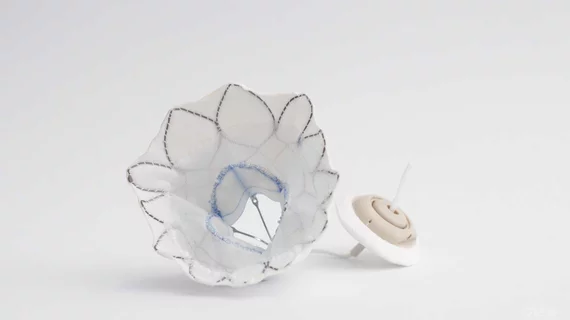An investigational transcatheter mitral valve replacement (TMVR) device helped reduce mitral regurgitation to zero or trace levels in 98.7 percent of patients, according to 30-day follow-up data from the first 100 people scheduled to be treated with Abbott’s Tendyne system.
The implant was successful in 97 of the patients, according to a May 23 press release which coincided with a presentation at EuroPCR 2018 in Paris. Ninety-nine of those patients had baseline mitral regurgitation of grade 3 or 4 on a four-part scale.
"Treating people with severe mitral regurgitation can be challenging because of advanced age, frailty or other complicating factors, and alternative treatments to surgery are needed," principal investigator David Muller, MBBS, MD, with St. Vincent’s Hospital in Sydney, said in the release. "These new data on the Tendyne replacement valve offer early hope for patients who are not eligible for transcatheter valve repair or surgery to relieve symptoms."
The researchers also noted improvements in symptoms based on New York Heart Association functional status and the Kansas City Cardiomyopathy Questionnaire. Six patients died during the 30-day follow-up but Muller et al. pointed out the 6 percent death rate is actually lower than the 7.9 percent expected mortality as calculated by the Society of Thoracic Surgeons risk score, which factors in age and comorbidities to predict long-term survival from surgical valve replacement.
Tendyne is currently under investigation in Europe, with a goal to enroll up to 350 patients in the clinical trial. According to Abbott, the retrievable system is the first of its kind specifically designed to replace the mitral valve without the use of open-heart surgery. Other investigators have studied the potential of valves used for transcatheter aortic valve replacement (TAVR) to be repurposed for TMVR.
Abbott said it plans to enroll the first patient in a U.S. pivotal trial of the Tendyne system in the next few months.
In other news from the company, the XIENCE Sierra everolimus-eluting coronary stent was approved by the FDA. The first XIENCE stent was approved in Europe in 2006 and in the U.S. in 2008.
The newest generation of the stent boasts a thinner profile, increased flexibility, longer lengths and smaller diameters, according to Abbott. It received CE mark approval in October 2017 and Japanese regulatory approval in April 2018.
"We developed XIENCE Sierra so that physicians can more easily deliver the stent even in challenging cases," Chuck Brynelsen, senior vice president of Abbott's vascular business, said in a release. "The updated design and improved deliverability mean doctors can access and unblock difficult-to-treat lesions with more flexibility and precision than other stents."

